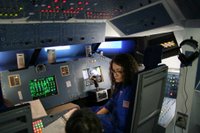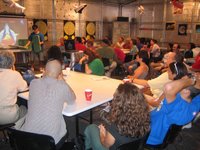
Naturally when you think of Space Camp you think of astronaut training (well if you are product of the 80's you probably first think of that cheesey movie "Space Camp" with Kate Capshaw and Lea Thompson which will then lead you back to thinking about astronaut training). This time was basically like playing at Disneyland and really gave us an appreciation in just how wild it must be to go throught training for the real thing. Even though all the teachers there came from different backgrounds and athletic abilities, it was almost like watching a bunch of kids running around an FAO Schwarz toy store.

Well the first step was to head into the Astro Trek building and hit the simulators. The most fun had to be the "multi-axis trainer" (or as we liked to call them the "vomit ball" - just take a look at the pics below and you will see why). Then for the ultimate weight ego boost, there is the 1/6th chair which simulates what it would be like to be on the moon with only 1/6th the gravity of earth. Finally we hit the MMU chair which simulates the propulsion unit that can be used on EVAs (extra-vehicular activities or commonly known as "space walks"). This whole chair unit is actually suspended on a cushion of air so you are basically a giant air-hockey puck!


Then came the time for us to pretend that we were a part of a real shuttle mission. This was probably the most stressful part of the week but also the most fun - I say "stressful" because we all took it so seriously and wanted to do good job. A large part of the facility is a huge room that actually has 4 different shuttles (orbiters) and parts of the space station in which we conducted missions.

We went through two, 2-hour mission simulations where we all played the parts from comanding the orbiter to being mission scientists doing EVAs (space walks) to operating the International Space Station to being the Flight Director in Huston.

In the first mission I was in MOCR (mission operation control room) where I played the part of CAPCOM - the person that is the main point of contact between mission control and the orbiter. We all had VERY detailed scripts to follow that covered literally a minute-by-minute layout of a real shuttle mission. In the second mission I was "Payload Specialist 1" which meant that during take off I am strapped into the "mid deck" and once in orbit the other PS and I conducted experiments (we actually made things like Flubber and other basic chemistry experiments)

Now when I said that it was a minute-by-minute script, I really meant it. I was amazed at the amount of detail and steps that the orbiter's Comander and Pilot had to go through. They had to complete an extensive checklist of flipping switches that I have to believe closely mirrors the real thing. I would have to say that my only disappointment was that I did not get to do a "space walk". True the space suit was like something you would wear to a Halloween party but it would have been wicked cool to be harnessed up and flying through the room. But as we learned, in NASA, there are no small parts to be played in a mission!

Besides the physcial activities associated with astronaut training, we also attended some incredible presentations on the space program that really helped to put things into perspective in what we were doing. We learned a lot about what it is like to live the floating environment of space (the big "no-no" was to call it "zero gravity" because the weightlessness was not due to a lack of gravity but rather do to a falling affect that you and all of your suroundings are "falling" all at the same rate AROUND the earth - this makes it seem like there is no gravity - as with everything, it all just a matter of perspective). We covered everything from sleeping, to exercise to conducting experiments to eating and yes, even how they go to the restroom (got to love "Mr. Thirsty").
 I was very excited to open up an email from Michael Holland, Director of Honeywell Hometown Solution telling me that I was selected to be a member of the 2007 Advanced Educator Space Academy. I am one of 35 people from around the world to go through this program that will be building on my incredible experience that you will read about here.
I was very excited to open up an email from Michael Holland, Director of Honeywell Hometown Solution telling me that I was selected to be a member of the 2007 Advanced Educator Space Academy. I am one of 35 people from around the world to go through this program that will be building on my incredible experience that you will read about here. 






















